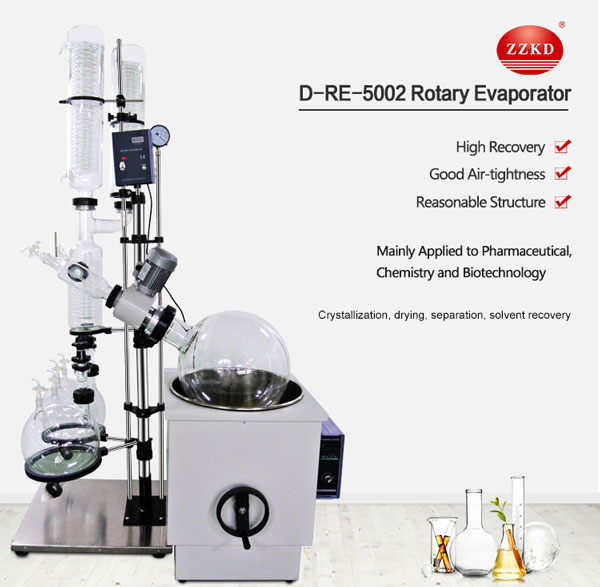20l Industrial Rotary Evaporator Rotovap Price
Product Description:
It is an equipment that is used for reduced pressure distillation. It is used to separate solvents from a sample. A rotovap machine typically consists of a water bath, a rotary flask, a rotary control panel, a condenser, a vacuum pump, and a collecting flask among others.
The flask that is used for heating the liquid mixture keeps rotating. This rotation process and heating under reduced pressure helps in heating solvents to a temperature at which they will normally decompose. The solvent derived from this process is typically so clean that it can be used many times over

Rotary Vacuum Evaporator Principle:
Rotary vacuum evaporator users tend to generally want to know the principle behind this complex and brilliant piece of laboratory instrument that they are using. Shortened to the rotovap, these are widely used in both biology and chemical laboratories across the globe. The rotovap has one main purpose and that is to efficiently and effectively allow the evaporation of solvents. So read on as we dive into the principle of the rotary vacuum evaporator.
Form a simpler point of view, the system features a rotating flask and a condenser that has its own collecting flask. The principle involved revolves around reducing the boiling points of the liquids while there is a decrease in pressure. In essence, this allows vaporization to occur at significantly lower boiling point temperatures while maintaining normal pressure.
The vacuum system employed in operations is one of the key factors responsible for making the process a success. In some instances, users are free to choose a vacuum pump that suits their needs while improving their evaporation efficiency. After the gas forms, there is a condenser on the other end that readily converts the gas to liquid at desired lower temperatures.
The system also relies on achieving the cooling effect. This is done with the use of liquid nitrogen, water or even dry ice. However, the evaporation chamber is always in constant rotation to increase the processing liquids surface area. Due to the constant rotation, the centrifugal force created prevents the fluids from sticking to the vessels inner surface.
Since the liquids don't stick to the surface, this allows faster evaporation because there is constant exposure to the larger surface area. A Swiss company was responsible for the creation of this state-of-the-art instrument which led other companies to also follow its design. These industrial rotary evaporators are quite expensive and require the most delicate form of care.
If you're new to using the apparatus, it is highly recommended that attention is paid to the manual. This also allows users to properly remove volatile solvents in the most efficient and environmentally friendly manner. Before the rotovap can be used, it must first be turned on and the vertical position of the glass apparatus should be adjusted. This is done by operating the manual lift knob located on the right side of the stand.
Making this adjustment ensures that there is enough space above the water bath. In order to proceed, the level and temperature of the water bath should be checked and topped up if need be. However, this is usually done with distilled water and the temperature can be altered with heat or ice.
Proper Technique For Using The Rotovap:
The waste solvent flask should be checked to prevent contamination with waste solvent. If the flask does have liquid, it can be removed and emptied into the waste drum. If there are signs of a dirty liquid, it should be removed and cleaned with some acetone.
The cooling water should then be turned on allowing gentle flow. The vacuum or water aspirator is then turned on. The stopcock is then observed to ensure that there is alignment with the venting hole. A sample solution can undergo industrial rotary evaporator by pouring in no more than half of the flask and the flask is then attached and secured.
If for some reason the industrial rotary evaporator joint doesn't match the size of the flask, an adaptor can be used to facilitate the size difference. In order to control the vacuum, you'll need to place a finger over the vent. If for some reason vigorous boiling begins to occur, some pressure should be released by removing your finger from over the vent.
As soon as the boiling has stopped, you'll then be able to reapply your finger to the vent. A gentle touch on the flask will also indicate cooling due to evaporation. When there is a noticeable amount of solution close to the stopcock, a vacuum pressure will be required to induce boiling. This is done by lowering the evaporation flask into the water bath.
In the event of rapid boiling, some pressure can be released with the stopcock. If slow evaporation is experienced, heat can be increased. However, since the apparatus is experiencing a vacuum, the typical solvent boiling point is usually around 40 degrees Celcius.
Once the evaporation process is completed, the flask can be removed with the manual lift knob. This allows the apparatus to be lifted out of the water. As long as the vacuum is released, the flask can be removed.
As we conclude, we have just looked at the industrial rotary evaporator principle. We have also looked at proper techniques for use. Remember to turn off the rotovap after using it.
Please Feel Free To Fill In The Form To Get rotovap price




